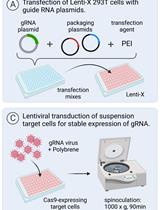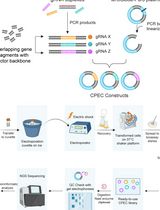- EN - English
- CN - 中文
An Affinity-directed Protein Missile (AdPROM) System for Targeted Destruction of Endogenous Proteins
靶向破坏内源蛋白的亲和力定向蛋白导弹(AdPROM)系统
发布: 2017年11月20日第7卷第22期 DOI: 10.21769/BioProtoc.2614 浏览次数: 9959
评审: Jihyun KimAmriti Rajender LullaAnonymous reviewer(s)

相关实验方案

在哺乳动物细胞中通过具有 3' 突出端的长 dsDNA 介导的 CRISPR 敲入 (LOCK) 实现高效的大 DNA 片段敲入
Wenjie Han [...] Jianqiang Bao
2023年10月20日 2701 阅读
Abstract
We recently reported an Affinity-directed PROtein Missile (AdPROM) system for the targeted proteolysis of endogenous proteins of interest (POI) (Fulcher et al., 2016 and 2017). AdPROM consists of the Von Hippel Lindau (VHL) protein, a Cullin 2 E3 ligase substrate receptor (Bosu and Kipreos, 2008), conjugated to a high affinity polypeptide binder (such as a camelid nanobody) that recognises the target protein in cells. When introduced in cells, the target protein is recruited to the CUL2 E3 ubiquitin ligase complex for ubiquitin-mediated proteasomal degradation. For target protein recruitment, we have utilised both camelid-derived VHH domain nanobodies as well as synthetic polypeptide monobodies based on the human type III fibronectin domain (Sha et al., 2013; Fridy et al., 2014; Schmidt et al., 2016). In this protocol, we describe detailed methodology involved in generating AdPROM constructs and their application in human cell lines for target protein destruction. AdPROM allows functional characterisation of the POI and its efficiency of target protein destruction overcomes many limitations of RNA-interference approaches, which necessitate long treatments and are associated with off-target effects, and CRISPR/Cas9 gene editing, which is not always feasible.
Keywords: AdPROM (AdPROM)Background
This protocol enables one to design, build and express AdPROM VHL-nano/monobody constructs in mammalian cell lines to achieve the proteolytic destruction of the endogenous POI. In the original entries, we demonstrated the near-complete destruction of specific target proteins, by using nanobodies that recognise either green fluorescent protein (GFP) (Fridy et al., 2014) or the inflammasomal protein ASC (Schmidt et al., 2016) and two distinct monobodies that recognize the protein tyrosine phosphatase SHP2 (Sha et al., 2013) as target probes, in a number of human cancer cell lines (Fulcher et al., 2016 and 2017). This protocol provides details for the generation of AdPROM constructs, their expression in cells, and monitoring of target protein degradation and can be adapted for use with any nanobody and monobody, both for constitutive and inducible degradation of the POI. The focus of this protocol is not on the generation of nano/monobodies against POIs or CRISPR/Cas9 genome editing (to knockin GFP tags on POIs) but rather the latter steps to facilitate target protein destruction with the AdPROM system.
Materials and Reagents
- Pipette tips (10 µl, 200 µl, 1,000 µl, alpha gel loading tips) (Greiner Bio One International, catalog numbers: 771290; STARLAB INTERNATIONAL, catalog number: S1111-1006 ; Greiner Bio One International, catalog number: 740295 and Alpha Laboratories, catalog number: LW1100 respectively)
- 15 ml Falcons tube (Greiner Bio One International, catalog number: 188271 )
- 50 ml Falcon tube (Greiner Bio One International, catalog number: 227261 )
- 10-cm tissue culture dishes (Thermo Fisher Scientific, Thermo ScientificTM, catalog number: 172931 )
- Micro tubes (1.5 ml) (SARSTEDT, catalog number: 72.706.400 )
- 0.45 µm sterile syringe filters (Sartorius, catalog number: 16555-K )
- 0.22 µm sterile syringe filters (Sartorius, catalog number: 16532-K )
- 96-well plates for tissue culture (Greiner Bio One International, catalog number: 655101 )
- Immobilon-®P PVDF membranes (Merck, catalog number: IPFL00005 )
- 10 ml plastic syringes (BD, BD Biosciences, catalog number: 302188 )
- Sterile disposable scalpels (Swann Morton, catalog number: 0503 )
- X-ray films (Konica Minolta, APLUS)
- HEK-293 FT cells for retrovirus production (Thermo Fisher Scientific, InvitrogenTM, catalog number: R70007 )
- Cell line of interest that expresses the target protein
Note: We used U2OS osteosarcoma, Human Embryonic kidney HEK-293, adenocarcinoma A549, and breast cancer MDA-MB-231 and MDA-MB-468 cells in the original entries (Fulcher et al., 2016 and 2017). - Cloning grade chemically competent DH5α cells (prepared in-house using a modified version of the Hanahan method (Sambrook and Russell, 2006))
- pBABED (Dundee modified pBABE vector) Puro FLAG vectors containing controls and AdPROM reagents for retrovirus production
Note: These may be obtained from the MRCPPU http://mrcppureagents.dundee.ac.uk/reagent-catalogues (refer to AdPROM cloning procedure below for details). - pCMV-GAG/Pol (Cell Biolabs, catalog number: RV-111 )
- pCMV-VSVG (Cell Biolabs, catalog number: RV-110 )
- pRetroX-Tet-On Advanced system plasmids for Tet-inducible AdPROM expression (Takara Bio, Clontech, catalog number: 632104 )
- Nano/monobody cDNA with flanking EcoRI/NotI sites (the sequences for the nano/monobodies constructs used in the original entries were obtained from the literature (Fulcher et al., 2016 and 2017))
- Restriction enzymes (FastDigest)–BamHI, EcoRI, DpnI and NotI (Thermo Fisher Scientific, Thermo ScientificTM, catalog numbers: FD0054 , FD0274 , FD1703 and FD0594 respectively)
- Ultrapure agarose (Thermo Fisher Scientific, InvitrogenTM, catalog number: 16500500 )
- Sequencing oligos (0.025 nM, Desalted) (Sigma-Aldrich)
- QIAquick Gel Extraction Kit (QIAGEN, catalog number: 28704 )
- Rapid DNA Ligation Kit (Thermo Fisher Scientific, Thermo ScientificTM, catalog number: K1422 )
- Ampicillin (ForMedium, catalog number: AMP25 )
- QIAprep Spin Miniprep Kit (QIAGEN, catalog number: 27104 )
- PureLinkTM HiPure Plasmid Filter Maxiprep Kit (Thermo Fisher Scientific, InvitrogenTM, catalog number: K210017 )
- KOD Hot Start DNA polymerase (Merck, catalog number: 71086-3 )
- Magnesium sulfate (MgSO4) (Sigma-Aldrich, catalog number: M7506 )
- Dimethyl sulfoxide (DMSO) (Sigma-Aldrich, catalog number: D8418 )
- Dulbecco’s modified Eagle’s medium (DMEM) (Thermo Fisher Scientific, GibcoTM, catalog number: 11960085 )
- Foetal bovine serum (FBS) (Labtech, catalog number: FCS-SA/500 )
- L-Glutamine (Thermo Fisher Scientific, GibcoTM, catalog number: 25030024 )
- Penicillin/streptomycin (Thermo Fisher Scientific, GibcoTM, catalog number: 15140122 )
- Opti-MEM (Thermo Fisher Scientific, GibcoTM, catalog number: 31985062 )
- Cell culture grade trypsin (Thermo Fisher Scientific, GibcoTM, catalog number: 25300054 )
- Polyethylenimine (PEI) (Polysciences, catalog number: 24765 )
- HEPES (Sigma-Aldrich, catalog number: H4034 )
- Polybrene (Sigma-Aldrich, catalog number: 107689 )
- Puromycin (Sigma-Aldrich, catalog number: P9620 )
- Phosphate-buffered saline (PBS) (Thermo Fisher Scientific, GibcoTM, catalog number: 14190169 )
- Non-fat dried milk powder (we use Marvel milk powder)
- 4-12% Bis/Tris gradient gels (Novex)
- Primary antibody that recognises the POI
Note: We used in-house generated antibodies recognizing VPS34 and FAM83G in the first of the original entries (Fulcher et al., 2016). Both antibodies can be made available upon request or purchased from the MRC-PPU Reagents Website (http://mrcppureagents.dundee.ac.uk/reagent-catalogues). For the second original entry (Fulcher et al., 2017), we used anti-SHP2 (C-terminus (Cell Signaling Technology, catalog number: 3397 ); and N-terminus (Cell Signaling Technology, catalog number: 3752 )) and anti-ASC (Martin Oeggerli, Adipogen, catalog number: AL177 ) antibodies. - Primary antibodies that recognise GFP (an anti-GFP antibody from ChromoTek, catalog number: 3H9), and in-house generated anti-GFP antibody, which can be purchased from the MRC-PPU Reagents Website (http://mrcppureagents.dundee.ac.uk/reagent-catalogues)
- Primary antibody that recognises VHL (Cell Signalling Technology, catalog number: 68547 )
- Primary antibody that recognises a house keeping gene (loading control) (We use anti-GAPDH (Cell Signaling Technology, catalog number: 2118 ))
- Bovine serum albumin (BSA) powder (Sigma-Aldrich, catalog number: A7906 )
- Enhanced Chemiluminescence (ECL) reagent (GE Healthcare, catalog number: RPN2106 )
- Secondary antibodies for primary antibody identification
Note: We use anti-sheep IgG-HRP (Santa Cruz Biotechnology, catalog number: sc-2770 ); and anti-rabbit IgG, HRP-linked (Cell Signaling Technology, catalog number: 7074 ) - G418/Geneticin (Thermo Fisher Scientific, GibcoTM, catalog number: 10131035 )
- Doxycycline (hydrochloride) (Sigma-Aldrich, catalog number: D3447 )
- Orange G (Sigma-Aldrich, catalog number: O3756 )
- Glycerol (VWR, catalog number: 24388.320 )
- Ethylenediaminetetraacetic acid (EDTA) (ForMedium, catalog number: EDTA250 )
- Tris (VWR, catalog number: 103157P )
- Sucrose (VWR, catalog number: 27480.360 )
- Sodium chloride (NaCl) (VWR, catalog number: 27810.364 )
- Ethylene glycol-bis(β-aminoethyl ether)-N,N,N’,N’-tetraacetic acid (EGTA) (Sigma-Aldrich, catalog number: E3889 )
- Sodium orthovanadate (Sigma-Aldrich, catalog number: 450243 )
- β-Glycerophosphate (Sigma-Aldrich, catalog number: G9422 )
- Sodium fluoride (Sigma-Aldrich, catalog number: S7920 )
- Sodium pyrophosphate (Sigma-Aldrich, catalog number: P8010 )
- Nonidet P-40 substitute (Sigma-Aldrich, catalog number: 74385 )
- β-Mercaptoethanol (Sigma-Aldrich, catalog number: M6250 )
- Protease inhibitor cocktail tablet (Roche Diagnostics, catalog number: 11836170001 )
- Glycine (VWR, catalog number: 10119CU )
- Methanol (VWR, catalog number: 20847.307 )
- Sodium dodecyl sulphate (SDS) (VWR, catalog number: 444464T )
- Bromophenol blue (Sigma-Aldrich, catalog number: B0126 )
- Hydrochloric acid (HCl) for pH adjustment (VWR, catalog number: 20252.335 )
- Tween 20 (Sigma-Aldrich, catalog number: P1379 )
- Gelatin (from porcine skin) (Sigma-Aldrich, catalog number: G2500 )
- DNA loading buffer (see Recipes)
- Lysis buffer (see Recipes)
- Running buffer (10x) (see Recipes)
- Transfer buffer (10x) (see Recipes)
- Sample buffer (5x) (see Recipes)
- TBS (10x) (see Recipes)
- TBS-T (1x) (see Recipes)
- TE buffer (pH 8.0) (see Recipes)
Equipment
- Water baths 37 °C and 42 °C
- Incubator/shaker 37 °C (Infors)
- Desktop centrifuge (4 °C)
- Desktop centrifuge (RT [room temperature])
- 500 ml Erlenmeyer flask
- Thermocycler (Thermo Fisher Scientific, Applied Biosystems, model: ProFLEX PCR System )
- Vortex (Scientific Industries, model: Vortex-Genie 2 )
- Humidified incubator for cell culture
- Sterile hood for tissue culture, suitable for category 2 work
- Pipettes (P2, P20, P200, P1000)
- Table-top heat block
- Gel electrophoresis apparatus (Peqlab)
- X-ray film developer
- Autoclave
- Nanodrop 1000 Spectrophotometer (Thermo Fisher Scientific, Thermo ScientificTM, model: NanoDropTM 1000 )
Procedure
文章信息
版权信息
© 2017 The Authors; exclusive licensee Bio-protocol LLC.
如何引用
Macartney, T. J., Sapkota, G. P. and Fulcher, L. J. (2017). An Affinity-directed Protein Missile (AdPROM) System for Targeted Destruction of Endogenous Proteins. Bio-protocol 7(22): e2614. DOI: 10.21769/BioProtoc.2614.
分类
癌症生物学 > 通用技术 > 分子生物学技术
分子生物学 > 蛋白质 > 靶向降解
您对这篇实验方法有问题吗?
在此处发布您的问题,我们将邀请本文作者来回答。同时,我们会将您的问题发布到Bio-protocol Exchange,以便寻求社区成员的帮助。
Share
Bluesky
X
Copy link













